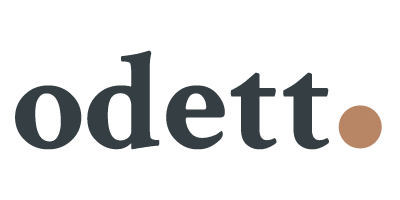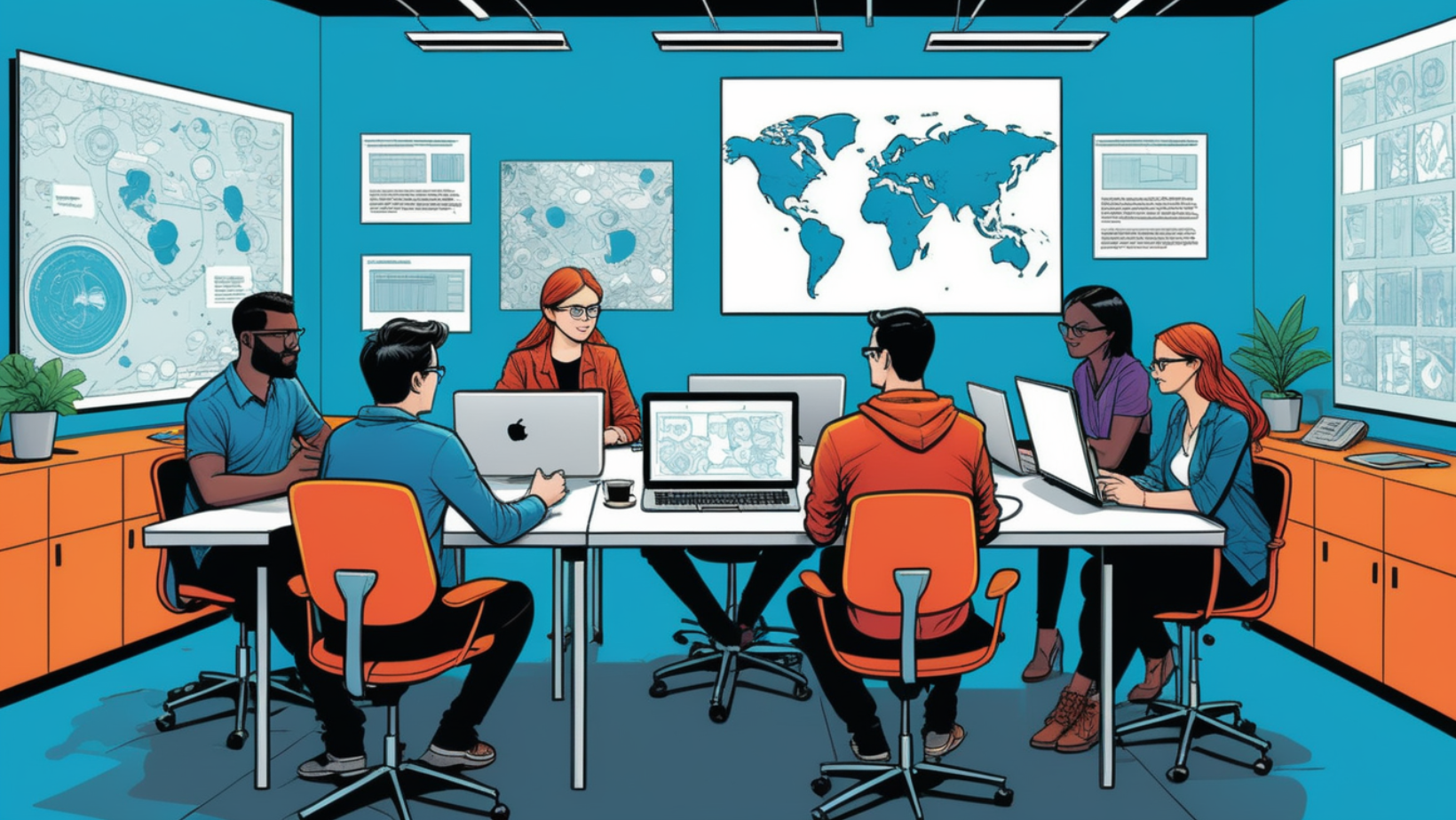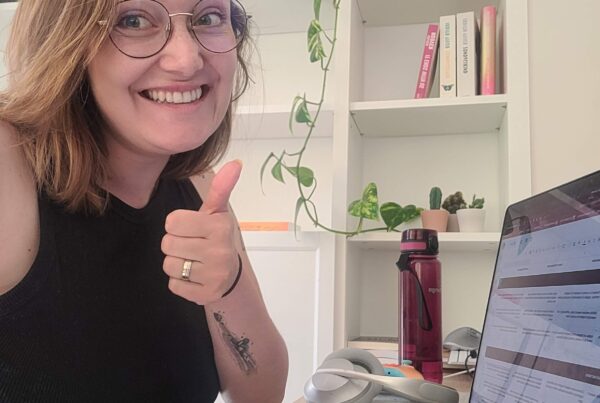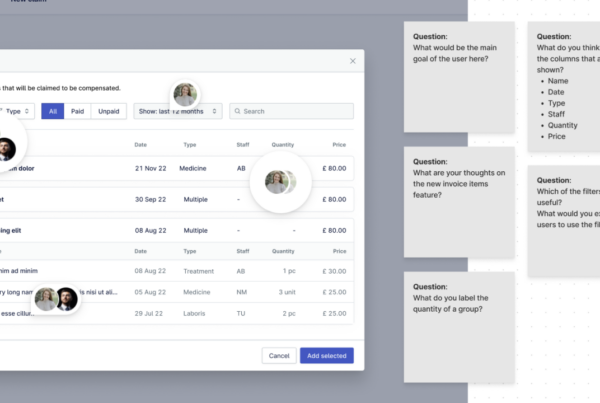In the ever-evolving landscape of digital products, the role of User Experience (UX) research has never been more critical. As someone who has navigated the intricacies of UX research, I understand that building and leading a successful UX research team is no small feat. It involves a myriad of elements, from understanding business goals to fostering a culture of continuous learning. In this article, I’ll share strategies and actionable insights based on my experience to help you build and lead a successful UX research team.
Crafting a Long-Term UX Research Vision
Before diving into hiring or team dynamics, it’s crucial to craft a long-term vision for your UX research team. Having a long-term vision provides a clear goal and a framework for building processes and strategies. My experience across various domains, including games, education, e-commerce, SaaS, and fashion, has shown me that companies without a vision often find themselves in a cycle of aimless creation or research. In contrast, a clear vision helps teams align their projects with overarching goals, ensuring every endeavor is a step towards the desired outcome.
Alignment with Company Goals
Aligning the UX research vision with company goals is crucial. While revenue and growth are common corporate objectives, forward-thinking companies also prioritize customer satisfaction and exceptional user experiences. Understanding these goals enables the crafting of a UX research vision that complements them. For instance, if a company aims to enhance customer satisfaction, the vision could emphasize driving UX research through customer feedback, ensuring the voice of the customer is integral to the development cycle.
At Nordhealth, where I currently lead the UX research, one of our primary objectives is to elevate the user experience and achieve higher NPS scores. However, my skepticism towards NPS as a sole measure of product success led us to a strategic shift. We decided to phase out NPS in favor of a more insightful customer satisfaction tool, aligning our approach with the company’s goal of garnering valuable user experience insights.
Leadership Mindset
Introducing a UX research culture in environments where common refrains are “we already know what the users want” or “do we really need to interview them?” can be challenging. The initial skepticism often stems from a lack of exposure to the tangible benefits UX research can offer. However, presenting real user data and insights can significantly shift this mindset. Seeing actual user experiences and feedback often turns skeptics into believers, underscoring the importance of UX research.
Over my decade-long career, I’ve navigated through biases and misconceptions, some even questioning the necessity of investing in UX research tools. However, showcasing the cost-saving and value-adding potential of UX research, especially through quick data wins on smaller projects, has often been a game-changer. It’s about communicating the ROI of UX research in a language that resonates with the business side of the organization.
Vision Evolution
Earlier in my career, I envisioned grand plans, only to realize the importance of attainable, clear, and concise visions. A good vision is one that can be realistically achieved in a foreseeable timeframe, yet flexible enough to evolve with changing business goals and strategies.
Communicating the Vision
Regular communication of the vision, especially during larger stakeholder meetings, ensures everyone is on the same page regarding the UX research team’s goals and strategies. It’s essential first to align the team on the vision, often through interactive workshops, ensuring it’s a collective goal everyone is striving towards. Subsequently, creating awareness among stakeholders helps in fostering a collaborative environment conducive to achieving the vision.
Vision in Practice
At Nordhealth, the absence of a UX research department presented an opportunity to build from scratch, aligning processes and strategies with the vision. Initiating with the product teams, I worked on embedding research into the design process, simultaneously hosting workshops to build a culture of UX research. These workshops, ranging from mockup observation analysis to practicing interviewing techniques, not only enhanced knowledge but also ignited enthusiasm for what UX research could bring to the table.
Feedback and Iteration
Reminding stakeholders of what the vision encompasses, and what it doesn’t, is crucial. For instance, while understanding legal implications is vital for our current product, it falls outside the purview of our UX research team, whose core focus is to represent the user’s voice. The vision isn’t set in stone; it evolves based on feedback and changing business strategies. Being in sync with the business’s vision and goals ensures that the UX research team’s work continually adds value to the company.
The Right Tools for the Job
Selecting the right tools is about striking a balance between minimizing the toolset and ensuring streamlined practices. A significant advantage arises when tools integrate seamlessly with each other, aiding in data collection, analysis, participant management, and linking them to the appropriate tests. The first step in tool selection aligns with understanding the company’s goal. For instance, if the objective is to improve customer satisfaction, tools that facilitate ethnographic studies, user interviews, and screen recordings become essential. In our case at Nordhealth, we chose Dovetail for its capabilities in transcribing, tagging, and analyzing data, along with its integration with Notion, our documentation repository.
Essential Tools
The essence of a good tool lies in its ability to organize work and save time. Tools that assist in tagging and analyzing interviews are indispensable, with software solutions significantly reducing the time spent on these tasks. Personally, I find Chat GPT-4 invaluable for inspiring or checking interview questions and quickly gathering scientific research. Dovetail stands out for its ability to swiftly transcribe, tag, and analyze data from interviews. Notion serves as an excellent platform for documentation, process management, and as a repository, while Useberry is my go-to for quick tests, surveys, and tree testing.
Budget Considerations
Budget constraints are a common challenge, and the key is to find a small toolset that efficiently covers 80% of the work. A cost-benefit analysis based on main tasks and available funds can help identify the ideal combination of tools. The market offers a range of tools, from well-known expensive ones to lesser-known yet equally effective alternatives. Integrations between tools can further optimize processes, saving both time and costs.
Tool Integration
Introducing a new tool involves creating a document outlining its goals and usage, followed by training from the tool’s company based on our specific scenarios. Recording these training sessions ensures a quick onboarding for new team members. Assigning a responsible person for each tool ensures smooth communication regarding updates or issues and keeps the documentation up to date.
Training and Adaptation
Securing training from the tool’s company based on our usage scenarios is crucial. Regular evaluations through surveys and discussions help in understanding the team’s experience with the new tool. At Nordhealth, I send out regular surveys to gather feedback on tool usage, and if necessary, schedule meetings with the tool account manager to address any issues.
Evaluating Tool Effectiveness
Regular evaluations through surveys help gauge the team’s satisfaction with the tools. If a tool doesn’t serve our purpose, we are open to exploring alternatives. For instance, we transitioned from Pendo to Mouseflow at Nordhealth to better understand user interactions with our software, as Pendo’s analytics were too limited for our needs.
Custom Tools
Creating custom templates in Notion for different research methods, consent forms, research plans, and using it as a repository has significantly streamlined our UX research processes. These custom tools have helped in organizing the UXR team efficiently, making every step of the research process more structured and coherent.
Exciting Possibilities
The potential of integrating AI into UX research is thrilling. We’ve begun experimenting with AI for proofreading research plans, and identifying missing components, and are keen on exploring transcript analysis soon. As AI continues to evolve, it holds the promise of further streamlining UX research, opening doors to new possibilities and efficiencies.
Hiring the Right Talent
Building a well-rounded UX Research (UXR) team is a nuanced endeavor that goes beyond merely evaluating individual competencies. It’s about creating a collective that complements each other, fostering a conducive environment for learning and growth, and ensuring a diverse representation to mirror the varied user base we cater to. Here’s a glimpse into my approach and experiences in assembling a UXR team at Nordhealth:
1. Identifying Talent:
- Complementary Skill Sets: When I embarked on expanding the UXR team, my focus was on finding individuals whose strengths could fill the gaps and create a harmonious synergy. For instance, while I excel in constructing and analyzing interviews, direct user interactions can be draining for me. Hence, the first addition to the team was someone with a penchant for user interactions, particularly conducting interviews.
- Continuous Learning: The field of UX research is ever-evolving, and so should be the curiosity of a UXR professional. Regardless of the experience level, a relentless drive to learn and evolve is a trait I value immensely. It’s not about knowing it all, but about self-awareness, the ability to reflect on one’s strengths and areas of growth, and the willingness to learn.
- Portfolio Review: A significant part of our interview process is a thorough portfolio review. We invite candidates to present a project they’ve worked on, walking us through their journey, challenges, and learnings. This not only gives us a peek into their technical prowess but also their problem-solving approach and passion for their work.
2. Diversity and Inclusion:
- Cultural Diversity: Our user base is globally dispersed, and having a culturally diverse team is a step towards understanding and catering to varied user needs. It’s fascinating how different cultural backgrounds bring in varied perspectives, communication styles, and problem-solving approaches, enriching the overall research process.
- Neurodiversity: As someone who identifies as neurodivergent, creating an inclusive environment where everyone feels safe and can thrive is close to my heart. While personal details are never probed during interviews, we do explore how candidates prefer to work through scenario-based questions, ensuring we can provide a conducive work environment.
3. Job Postings and Outreach:
- Networking: The digital world has made networking seamless. Platforms like LinkedIn have been instrumental in connecting with talented individuals. While sifting through hundreds of applications can be daunting, having interacted with someone at a conference or online creates a memorable impression, making the selection process a tad bit easier.
The journey of assembling a UXR team is as much about the individuals as it is about creating a collective that resonates with the broader organizational vision, is eager to learn, and represents the diverse user base we cater to. It’s a meticulous process but an enriching one, with learnings that transcend the professional realm.
Fostering Team Growth and Collaboration
Once the team is in place, the next step is to foster an environment that encourages growth and collaboration. Regular team meetings, one-on-ones, and cross-functional collaborations with designers and product managers can go a long way in building a cohesive and effective team.
Building a Cohesive Team
Creating an open and honest culture is the cornerstone of a strong team. It’s essential to have a platform where team members can express their feelings, discuss projects, and share their day-to-day experiences. While traditional team-building activities may not resonate with everyone, setting aside time for social interactions, like game afternoons, fosters stronger bonds and creates a relaxed atmosphere where everyone can unwind and enjoy. Modeling the behavior you wish to see is a powerful way to instill a culture of open communication and transparency. Being forthright about the business’s goings, project statuses, and encouraging open-ended discussions cultivates a growth mindset.
Professional Growth and Recognition
Setting aside dedicated time for professional development is a practice that pays dividends in the long run. At Nordhealth, a two-hour slot every week is allocated for this purpose, allowing team members to explore new methodologies, engage with industry experts, or pursue courses that enhance their UXR skills. Recognizing and appreciating the efforts of team members is crucial for maintaining high morale and motivation. Whether it’s acknowledging the individuals responsible for a project’s success during stakeholder presentations or offering meaningful compliments, these gestures contribute to a positive work environment.
Conflict Resolution and Feedback Culture
Conflict is inevitable, but how it’s managed can make a significant difference. Approaching conflicts with a growth mindset, identifying the root causes, and working together to find solutions ensures that disagreements become opportunities for improvement rather than sources of discord. A culture of regular feedback, through weekly sprint reviews and daily updates on Slack, ensures that the team stays aligned, celebrates achievements, and continuously learns from each other.
Remote Work and Work-Life Balance
Promoting a healthy work-life balance is integral for a productive and happy team. The agile sprint methodology adopted at Nordhealth allows for a flexible work schedule, ensuring that the team achieves its goals without feeling overwhelmed. The transition to remote work has, surprisingly, enhanced the team’s productivity and collaboration. By working asynchronously and having set meetings, team members enjoy ownership over their time and space, which in turn, motivates them to contribute effectively to the team’s goals.
Measuring Impact and Communicating Value
In User Experience Research (UXR), measuring impact and communicating value is pivotal for aligning the research outcomes with business goals. At Nordhealth, a structured approach towards these aspects has been adopted to ensure that the UXR efforts are not only effective but also recognized and appreciated across the organization.
Establishing Relevant Metrics
The journey begins by identifying key performance indicators (KPIs) that resonate with the project at hand and the overarching business objectives. Collaborating with management stakeholders, the UXR team at Nordhealth zeroes in on metrics that would provide a clear picture of user satisfaction, task time, task success rate, and other user interactions. Tools like Mouseflow come in handy for analyzing user behavior metrics such as bounce rates, rage clicks, and mouse-outs. The essence is to have a set of measurable variables that can directly or indirectly indicate the impact of the UXR initiatives on product design and user satisfaction.
Regular Communication and Presentation of Findings
Communication is the bridge that connects the UXR team with other stakeholders within the organization. Regular updates on research findings are shared via Slack on a weekly basis, and more detailed insights are presented to product teams and, on a broader scale, to the entire company, depending on the significance of the project. The transparency in sharing the progress and outcomes of UXR projects fosters a culture of inclusivity and keeps everyone in the loop regarding the advancements in product design and user satisfaction.
Visualization and Engagement
Utilizing Figma for presenting findings has harmonized the communication process with the design teams. By visualizing the data in a more engaging and visually pleasant manner, the UXR team ensures that the insights are not only informative but also captivating for the stakeholders. Moreover, engaging stakeholders right from the kickoff sessions of a research project, involving them in the research plan discussions, and even training some to participate in user interviews, creates a sense of ownership and engagement across different teams.
Continuous Advocacy and Collaboration
Advocacy for UXR is a continuous endeavor at Nordhealth. Through presentations, documentation updates, and constant communication with Project Managers (PMs), the UXR team emphasizes the importance of measuring the impact and communicating the value of UXR initiatives. The collaborative approach in determining metrics for each project with PMs ensures that the research goals are aligned with the business objectives. Moreover, keeping abreast with industry trends and engaging with other UXR professionals helps in evolving the measurement and communication strategies to stay relevant and effective.
Ethical Considerations in UX Research
In the pursuit of insights and data, it’s easy to overlook the ethical aspects of UX research. Ensuring user privacy, informed consent, and responsible data handling are non-negotiable elements that every UX research team should focus on. Here’s how these principles are upheld in practice:
Informed Consent and Data Protection:
Before any research activity, informed consent is obtained from participants, with tailored consent forms for different project types. Data collected is securely stored using GDPR-compliant tools like Dovetail, with participants informed about the data retention period.
Transparency, Engagement, and Respect:
Transparency is maintained by keeping participants and stakeholders informed about research goals and findings. Training programs ensure respectful interactions between researchers and participants. Regular updates and presentations, along with a culture of mutual respect, foster continuous engagement and learning.
Avoiding Bias and Ensuring Representation:
Method, researcher, and time-triangulation help mitigate biases. Hiring experienced UX researchers instead of domain experts ensures a balanced approach to data gathering. A meticulously curated user database facilitates diverse and representative participant selection, promoting inclusivity and a broader understanding of user experiences.
Accountability, Continuous Learning, and Industry Engagement:
Clear protocols and regular team discussions foster accountability and continuous improvement. Engaging with industry experts and staying updated on evolving ethical standards enrich the ethical framework guiding the research process, ensuring it remains robust and aligned with industry standards.
Conclusion
Building and leading a successful UX research team is a multifaceted endeavor that requires a strategic approach, the right set of tools, and a focus on continuous improvement. By crafting a compelling vision, hiring the right talent, and fostering a culture of collaboration and ethical responsibility, you can set your team on the path to success.




